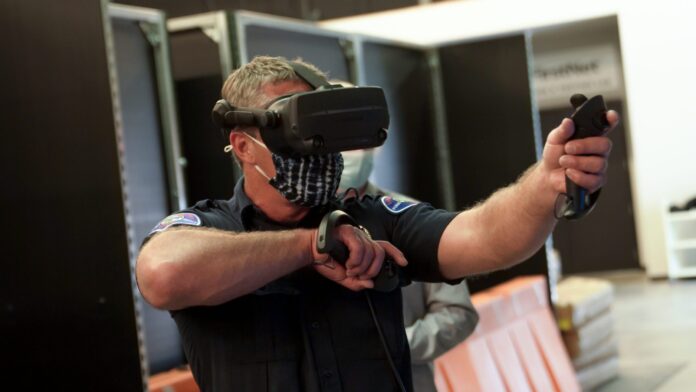The immersive lab, a partnership between the FirstNet Authority and NIST’s PSCR, enables both training and tech R&D
During the Marshall Fire, which burned around 1,000 homes in small towns west of Boulder, Colorado in late December 2021, the First Responder Network Authority’s technical quarters in Boulder was a little too close to the fire for comfort. Although the path of the Marshall fire’ main destruction lies about two miles southeast, half a dozen homes just on the other side of the FirstNet building’s parking lot were among many across Boulder area that sustained minor damage, according to a county fire damage assessment.
Even as some employees were evacuated from their own homes, the FirstNet lab provided a compact deployable to local responders in the area who needed to bolster coverage, recalled FirstNet Authority Chief Network and Technology Officer Jeff Bratcher. It was real-world experience for local staff on the use and importance of FirstNet’s technology in the real world.
More recently, however, the FirstNet lab has been focused on the virtual world—and how a new augmented and virtual reality test center can help develop new technologies for training and preparation for public safety response.
The Public Safety Immersive Test Center takes up about a little more than a thousand square feet in FirstNet’s technical headquarters, and as Bratcher explains, it integrates a number of technologies that are strongly associated with movie-making or gaming: A motion-capture system, 42 high-speed optical tracking cameras, AR and VR headsets, moveable walls and various gear and fixtures that enable first responders and tech developers to run scenarios like search-and-rescue or a terrorist attack.

Bratcher says that the lab space’s goal is “building a physical world to match what’s in the virtual world,” to allow users to “not only see, but touch” the common objects that they would encounter in such scenarios. There are modifiable routes set up in the space with physical objects that currently mimic the layout of rooms in a house, such as a bedroom or kitchen with an island. The FirstNet Authority and NIST say they plan to make regular updates to expand the use of haptic feedback, edge computing, FirstNet 5G and WebXR capabilities that allow VR and AR to be combined.
But it’s not all about the fancy tech. “This facility enables us to take our research to the next level by allowing natural interactions,” explained Scott Ledgerwood, who leads NIST PSCR’s work on user experience and user interfaces, in a statement on the lab. “Traditional virtual reality simulations required controllers for interaction, which didn’t translate well to real-life scenarios. In this new facility, users can walk or crawl throughout the space, physically touch walls and furniture, and pick up props like fire nozzles or dummies. This approach will improve measures and build confidence in the test results for translations of technologies to the real world.”
This is a joint effort with the National Institute of Science and Technology’s Public Safety Communications Research (NIST PSCR) unit, Bratcher says, which is also located in Boulder. The two organizations already work closely together, and FirstNet had a space htat was an ideal fit for the lab, Bratcher says, including the ability to mount cameras overhead. The lab is meant to provide a space for both public safety R&D so that tech developers can get a sense of how their solutions perform for public safety users in realistic scenarios, such as how well sensors can track the location of a firefighter moving through a home or using AR glasses to provide a virtual view of fire training grounds. Right now, according to Bratcher, there is a lot of interest in location-based services such as location tracking of responders, or dropping “breadcrumb” sensor for situational awareness. The lab is also meant to be a place for no-cost education and training for public safety agencies and organizations which support public safety response—designed, as FirstNet puts it, “to help answer key research questions around the future of user interfaces and location services for public safety training and operations” in part by involving first responders to give firsthand feedback, which has been a mainstay of FirstNet’s strategy throughout the agency’s existence thus far.
Bratcher says the has already been used by some local public safety agencies, including the Mountain View Fire and Rescue agency in nearby Longmont, Colorado.
“The center is giving us a glimpse into the future,” said Sterling Folden, deputy chief of Mountain View Fire and Rescue in Longmont, Colorado, in a release on the lab. “It’s very promising to see the technology that is being invested in to augment whatever we do and the tools we’ll have in the future to make our citizens safer. All these forms of technology from the facility have the opportunity to be implemented in the field. Some lend themselves better to training like VR, but augmented reality can be implemented in the field sooner rather than later and make a big difference for people.”

